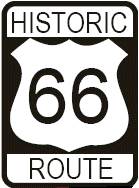In 1907, the Oklahoma State Constitution made provision for the creation of a State Highway Department; however, four years passed before the Legislature authorized the appointment of personnel and a source of funding. In 1911, Sidney Suggs was appointed Oklahoma's first Highway Commissioner. Revenue for the Department was generated by a registration fee of $1.00 for each automobile in the state.
Between 1911 and 1914, the Department was greatly handicapped by lack of funds and pursued the promotion of "Good Roads" assisted by various "Good Roads" associations throughout the state. Local citizens, township, and county authorities banded together with various commercial trail clubs and county "Good Road" associations to create a network of roads for the traveling public. Literally overnight, long stretches of highways were improved by the energy and combined efforts of these individuals and organizations. Much credit is due Commissioner Suggs, whose untiring effort and visions of the future brought together those Oklahomans interested in good roads, thus establishing the nucleus of Oklahoma's State Highway Department. Under Sugg's direction, Oklahoma was in the front rank of states demanding aid from the Federal Government for highway improvements. In 1914, a highway system of 2,400 miles was developed for submission to the Joint Committee of Congress on Federal Aid.
During the period 1915 to 1923, additional state revenue and increased personnel allowed the Department to develop into an organization of centralized authority for road construction. The passage of the 1916 Federal Aid Road Act enabled the Department to construct roads and bridges with matching Federal monies. The first Federal-aid project (FAP 1) was the Newcastle Bridge across the Canadian River in Cleveland County completed in 1922. Maintenance of the highway system was still entirely under the supervision of the various counties and local city governments. Signing of the various routes was accomplished by "Good Roads" associations and commercial auto trail booster groups. Auto trails bearing names like the Albert Pike Highway, Ozark Trails, Jefferson Highway, Meridian Highway, Kansas City-Tulsa Short Line, and the King of Trails were marked across the state, guiding motorists from place to place. Some of the trails were regional routes traversing several states linking major cities and popular resort havens. Being supported through individual private donations, markers for the early auto trails varied from simple painted wooden signs on fence posts to elaborate concrete pyramids 22 feet tall such as those constructed for the Ozark Trails. Many auto trails overlapped stretches of the same road and multiple route markers frequently caused havoc for the motorists. Although many problems existed, the prime motive of these early highway boosters was the establishment and promotion of safe, passable roads moving people across America.
The year 1924 heralded the beginning of a new epoch of Oklahoma highway activities. Legislation was enacted to bring the state in line with the amended Federal Aid Highway Act of 1921. Additional funds for construction were authorized and maintenance of the State Highway System was placed under the State Highway Commission. A proposed system of state numbered highway with uniform signing was adopted to eliminate the descriptively named and sometimes confusingly marked auto trails. The State Highway Commission was changed from a one man to three men commission, headed by chairman Cyrus S. Avery of Tulsa, a former county commissioner and staunch supporter of the "Good Roads" movement. Avery had served as vice-president of the Ozark Trails Association and president of the Albert Pike Highway Association.
By 1925, traffic demands on Oklahoma's highways were well ahead of the development of the highway system. The Legislature again amended the highway laws to generate increased revenue for construction and maintenance. Oklahomans were finally getting out of the mud and onto state numbered routes with paved and graveled surfaces. On the horizon, a national system of interstate highways was being developed by the Federal Bureau of Public Roads and the American Association of State Highway Officials. In 1925, Oklahoma's State Highway System totaled 5,156 miles, of which only 374 were paved. That same year, the first state highway tourist map was published for distribution to the motoring public.
During the next fifteen years, the State Highway System was gradually improved to a network of state and US numbered routes grew to 8,782 miles, with 5,118 being hard surfaced. Of all the highways crossing Oklahoma, one route, US 66, became the single most important artery for traffic between the heartland of the nation and the coast of Southern California. It was a diagonal highway created from a composite of earlier state roads (State Highways 3, 7, and 39) and auto trails (Ozark Trails, Kansas City-Tulsa Short Line and Postal Highway). Route 66 was commissioned by the Secretary of Agriculture as part of the national highway system in November 1926, and signing was erected across Oklahoma by April of 1927. It was a route Commissioner Averytold the Bureau of Public Roads "that the U.S. Government will be proud of."
|





